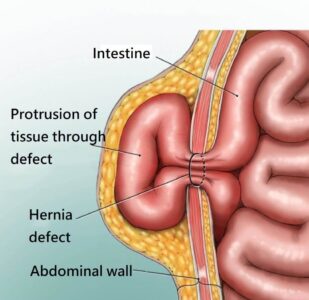
What is Femoral hernia?
Femoral hernia is a subcutaneous swelling just below the inguinal ligament. When abdominal contents pass through the femoral canal, a weak point in the abdominal wall, a femoral hernia forms. Femoral hernia is an uncommon type, accounting for only 3% of all hernias. Although most hernias can occur in both males and females, almost all femoral hernias develop in women due to the increased width of the female pelvis. Femoral hernias are more common in adults than in children.
Femoral hernias typically present as a groin lump or bulge, which may differ in size during the day. The lump or bulge is typically smaller than an inguinal hernia. It may or may not disappear completely when lying down. They may or may not be associated with pain.
The lump of a femoral hernia is more roundish or ovoid, whereas the inguinal hernia is more pear-shaped. The swelling of a femoral hernia usually lies below an imaginary line drawn between the anterior superior iliac spine and the pubic tubercle (which essentially represents the inguinal ligament), whereas an inguinal hernia starts above this line. The cough impulse is often absent in femoral hernias and is not reliable for diagnosis.
Femoral hernias often present with varying degrees of complications ranging from incarceration and intestinal obstruction to bowel strangulation. The incidence of strangulation in femoral hernias is high. A femoral hernia has often been found to be the cause of unexplained small bowel obstruction. Nonetheless, it may not be possible to distinguish the two before surgery.

Complications
Most femoral hernias present as painful, irreducible groin swellings with incarceration, bowel obstruction, or even bowel strangulation. Incarcerated hernia occurs if the contents of the hernia become trapped and cannot return to the abdomen. It can obstruct the bowel, leading to severe pain, nausea, vomiting, and the inability to have a bowel movement or to pass gas. Strangulated hernia is a dangerous stage of incarcerated hernia with the blood flow cut off (ischemia) to the hernia content, mostly small bowel and omentum. Strangulation can lead to gangrene of the affected small bowel tissue, causing bowel rupture, peritonitis, or even death. A strangulated hernia is a potentially life-threatening situation and requires immediate surgery.
Signs and symptoms of a strangulated hernia include:
- Nausea
- Vomiting
- Fever
- Painful groin swelling
- Inability to pass feces or gas
- Severe abdominal pain
- Tenderness upon touching
- Red, purple, or dark discoloration of the hernia
- Failure of reducing the hernia
If you have the signs and symptoms of a strangulated hernia, go to the nearest emergency department immediately.
Diagnosis
Femoral hernias can often be diagnosed clinically, based on signs, symptoms, and physical examination. Medical imaging, such as an ultrasound scan, CT scan, or MRI scan, may be needed to confirm the diagnosis or rule out other possible causes, such as an inguinal hernia.
For example, a female patient with a painful groin lump and abdominal X-rays showing small bowel obstruction is a typical presentation of a femoral hernia with incarceration and bowel obstruction.
Indication for Surgery
Femoral hernias are hernias that usually need early surgery due to the high incidence of complications, such as incarceration, bowel obstruction, strangulation, bowel infarction, and bowel perforation. If surgery is done on an elective basis, the complication risk is very low. On the contrary, if surgery is performed for incarceration, bowel obstruction, or strangulation, the complication risks are significantly higher.
Surgery
Femoral hernias often need emergency surgeries as they frequently present with incarceration, intestinal obstruction, or bowel strangulation. If emergency open surgery is necessary, the wound required to return the hernia content and to fix the mesh may be larger (~10-15 cm). If there is a gut infarction or perforation, laparotomy will be required to address the problem.
Elective Surgery
- Open hernia surgery:
- Traditional open hernia surgery typically requires a 6 cm - 8 cm skin incision to securely repair the hernia, with or without the use of artificial mesh.
- Small incision open hernia surgery uses a smaller incision (3 cm – 4 cm) to repair the hernia, with or without the use of artificial mesh.
- There are several femoral hernia surgical methods to repair a femoral hernia. Please consult your surgeon for advice.
- Laparoscopic hernia surgery:
- Laparoscopic hernia surgery, or keyhole surgery, generally requires three small 0.5 cm - 1 cm incisions to pass the instruments into the abdominal cavity, repair the hernia, and fix the mesh.
- This approach causes less pain and reduces the downtime for patients. Please consult your surgeon for advice.
Postoperative events
Most patients undergoing elective surgical repair do very well and may be able to go home the same day or one day after surgery. The outcome of elective surgery is generally very good and the risk of complications is low. However, emergency repair carries a higher bowel complication risk, and greater morbidity and mortality rates. Patients undergoing emergency surgery are expected to stay in the hospital for about 1 to 2 weeks.
Oral analgesics and long-acting local anesthetics are often used to minimize postoperative wound pain. Absorbable subcutaneous stitches are commonly used to close the hernia wounds, eliminating the need to endure pain during the removal of superficial stitches. Patients are usually required to keep the wound dry for 2 - 3 weeks. After this period, all wound dressings can be removed. Patients can typically return to office work 1 to 2 weeks after surgery and resume exercise 4 to 6 weeks after surgery.
















